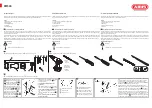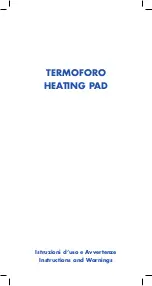
the higher value for a cable over 200 Ω. The resistance value of the cable is
indicated on the label attached to the end of the cold lead. Compare the test
result with the resistance indicated on the label. Record the results on the
limited warranty card. The measurement should be similar to the resistance
indicated on the cable label (± 10%). The cable’s resistance was established
in an environment at 20 ˚C (68 ˚F). If you obtain a reading that does not
correlate with these parameters contact FLEXTHERM customer service at
1-800-353-9843.
Test 1: Cable insulation test
Connect the unit’s black cable to the ground
wire (green wire) and the red cable to one of
the black conductors.
Rotate the dial to select the position
1000V (heating cable).
Press (hold down) the TEST button for
10
seconds.
Test 2: Cable resistance test
Connect the clips to the black wires.
6HOHFW
(Heating Cable).
Validate the result with the heating
cable’s specifications located on the label.
Acceptable tolerances are between ± 10%.
Test 3: Probe sensor test
Inf. (OL)
P
3DVV
P P
&ULWLFDO
P
)DLO
Results:
Reference Card
Connect leads to the probe.
Rotate the dial to select the position
.)ORRU3UREH
The result should correspond to the value
indicated in the installation guide or on the
sensor
tag.
2005.1 Multifunctional
Warning: Risk of electric shock
(do not touch the cables)
Insulation Verifi cation
Use a megohmmeter to verify the cable insulation integrity. Connect the
instrument’s black cable to the system ground wire (the green lead) and
the red cable to one of the heating elements (black leads), and then send a
1000 V current (
picture 2
). This result should be “infinite” ohms. Should there be a
current leakage between the heating element and the insulation the appliance
will indicate a result between 0 and 500 MΩ. When this test is performed with a
FLEXTEST unit, refer to the unit’s reference card to interpret the results.
Picture 2
Record the Results
IMPORTANT
: Record the results obtained for these two tests
on the limited warranty card every time you perform them:
before breaking the seal, after the cable is secured to the mesh
and after it is buried in concrete. These results must be
recorded on the warranty card in order to preserve the system’s
limited warranty.
Should the results obtained not comply with cable specifications, do
not break the cable seal and contact FLEXTHERM customer service at
1-800-353-9843.
Preliminary Electrical Installation
Circuit
Floor heating systems should be connected to electrical circuits dedicated
to heating. The amperage drawn by the cable sets, as indicated on the cable
labels, will determine the required circuit intensity. Please take note that the
maximum load that can be supported by a FLEXTHERM thermostat is 15 A.
More than one circuit will be necessary should the system require more
than 15 A. For a load greater than 15 A, a master/expansion conversion kit
with the appropriate number of expansion units are required. A FLEXTHERM
thermostat can control up to 10 expansion units. For further information
regarding their connection, please refer to the literature included with those
products, also available on our web site at www.flextherm.com.
Electrical Connection Box
Determine where the thermostat connection box will be installed. It should
be in an accessible location, in the room where the system is installed and at
an appropriate height.
Use an expanded thermostat connection box or a 4 in x 4 in box for the
system connection (plan one connection box for each 15 A circuit). On
the first end of the cable is a 3 m (10 ft) cold lead to make the appropriate
connection. Note that the floor probe is included in the FLEXTHERM
thermostat box.
IMPORTANT
: Connect the cable to the thermostat only once
the cable has been installed and covered
Note: Keep ends of heating devices and kit components dry before and
during installation.
Cold Lead
The cold lead is the non heating part of the cable that will run in the wall
to connect the system to the thermostat. The cold lead is flat and red. It is
connected to the heating cable with a mechanical joint. Just like the heating
cable, the mechanical joint must be embedded in the concrete slab.
Determine the location where the mechanical joint will be fastened. Slide the
cold lead inside a cable conduit according to the local and national code in
force in your area. Pull on the cable until the mechanical joint is at a distance
of about 30 cm (12 in) from the cable conduit bottom edge (
picture 3
).
Picture 3
3
Green Cable
Concrete
Installation Guide




































